The information contained in this sticky is provided for educational purposes only and is not intended to replace veterinary advice. The intention of this sticky is to open doors to understanding about the specific medical condition or topic, allowing for educated and on-going discussion with your vet.
Many human insulin types now come in pen form and this trend is becoming more popular when it comes to insulin for diabetic cats. The problem with using the pens is they only allow for half or full units of insulin to be dosed, where with TR we typically give insulin in much smaller, fractional increments. If your vet is planning to prescribe pen form insulin to you, we recommend you ask for a prescription for refill cartridges and syringes with half unit markings to match the insulin instead. If you've already got insulin in pen form, it is possible to use syringes to access the insulin inside.
If after reviewing this sticky, you have any questions about which insulin syringes to use, please post on Talking TR for assistance.
|
|
The top photo is a U40 syringe which come
with red caps and needles covers, and are also available with red
unit marks. U40 syringes are made to hold 20.0u of U40 insulin or
less. Once difficult to find,
American
Diabetes Wholesale and
EliMedical Canada now sell U40 syringes with half unit markings,
however you will need a prescription.
Your vet will tell you U40 insulin must be used with
U40 syringes however, it is possible to use U40 insulin
with U100 syringes doing a volume conversion. The important thing is to get
syringes with half unit markings.
We recommend using the syringe in the bottom of the photo which is a 3/10cc (ml) 100 syringe, for use with 30.0 units or less of U100 insulin. They have orange caps and needle covers. U100 syringes come with both full and half unit marks. Syringes with half unit marks make measuring the small increments given on TR much easier and more accurate. If from Europe, the description is 3/10ml, for 30 units or less, demi (descriptor for half unit markings). The cc and ml unit of measurement is the same. U100 syringes can be utilized with U40 insulin by using the conversion chart. |
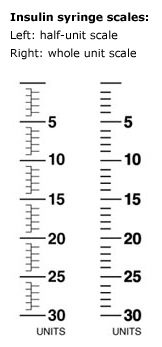
|
Half unit marks make for much easier
measuring of half and quarter units, as well as the
"fats and
skinnies" we use
when dosing our cats on TR. Most vets do not
support the use of U100 syringes with U40
insulin. Using the conversion
chart for U40
insulin and U100 syringes, we are able to much more
accurately measure very small increments of
insulin.
Most U40 insulin syringes do not have half unit marks, but they are available online at ADW. Half unit markings make accurate and consistent measuring of small doses far easier.
|

|
The gauge of U100 syringes varies from 25 gauge (thickest) to 33 gauge (thinnest). The most commonly found 3/10cc syringes with half unit marks are found in gauges 29, 30 or 31. While a thinner gauge needle may hurt less during injection, the thinner the gauge, the more chance the needle may bend when giving shots. |
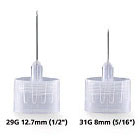
|
The needles on insulin syringes come in two lengths, 1/2" (longs - left photo) or 5/16" (shorts - right photo). Some people find short needles are sometimes easier to control. Longer needles tend to work better for cats with a thicker layer of fat, getting in past the fat layer for better insulin absorption. The choice to use longs or shorts is generally a matter of personal preference. |
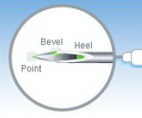
|
Many find there are better absorption results if the bevel of the syringe is facing outwards when giving shots. Injecting with the bevel side facing up/out allows for the needle to slide into the skin much easier resulting in shots being less painful. For more information click here. |
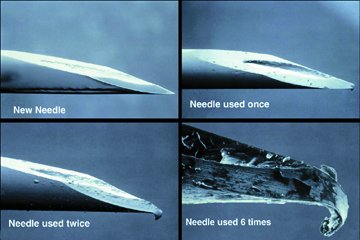
|
Insulin syringes are meant to be used one time only. In an emergency, they can be cleaned with vigorous rubbing alcohol rinses, but this is not recommended unless absolutely necessary. When the needle is inserted, chunks of skin clog the needle; the tip of the needle become blunt hurting more when injected into the skin. To learn more about needles damaged by reuse, click here. |
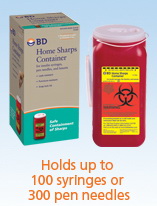
|
More than a billion
insulin syringes, needles, and lancets are used for
diabetes care in the United States alone each year. If
they are not disposed of properly, these items, known
as "sharps", can injure other people.
The rules and regulations regarding sharps disposal may be different in towns and counties around the world. Please check with your local sanitation or health department for information about how to dispose of used syringes properly. |
Graphic courtesy of Becton, Dickinson and Company
© 2009-2025 Diabetic Cat Care - DCC's information may be used on other websites (with restrictions), for more information read All Rights Reserved